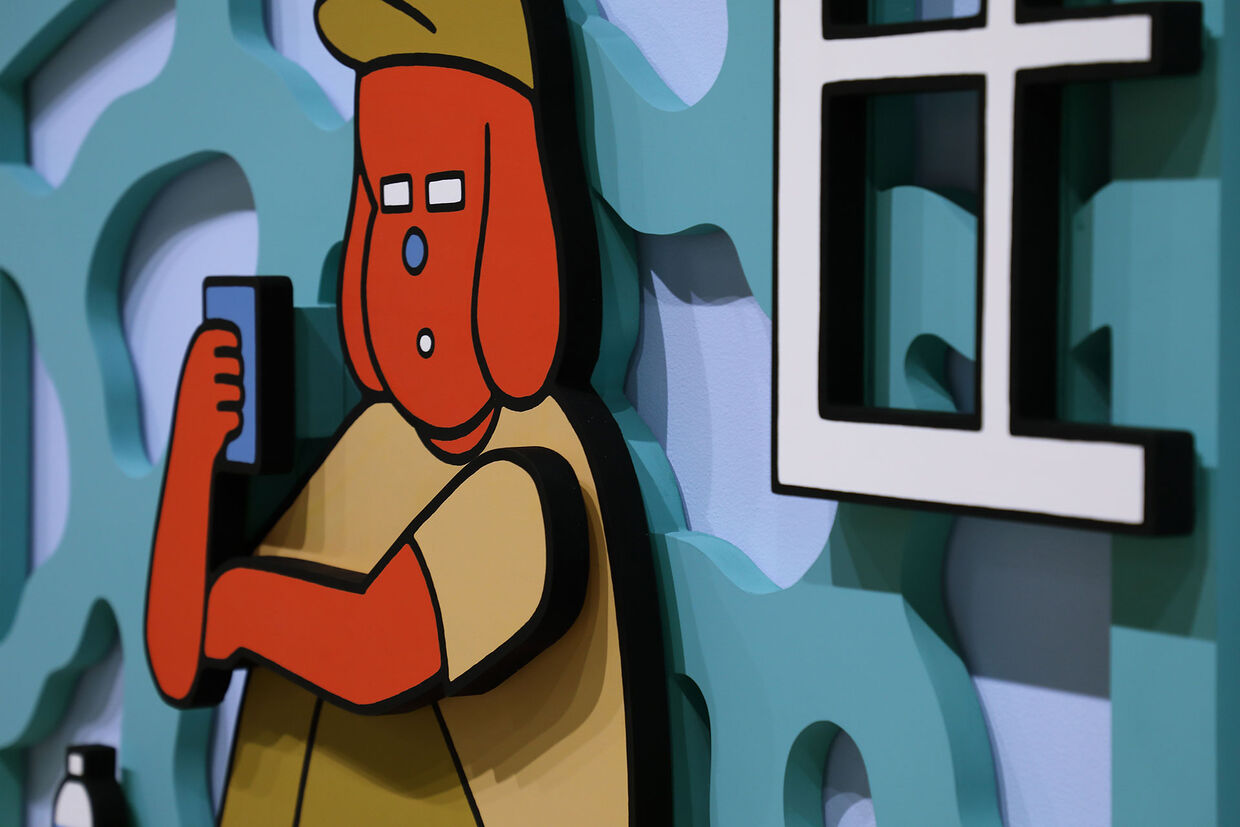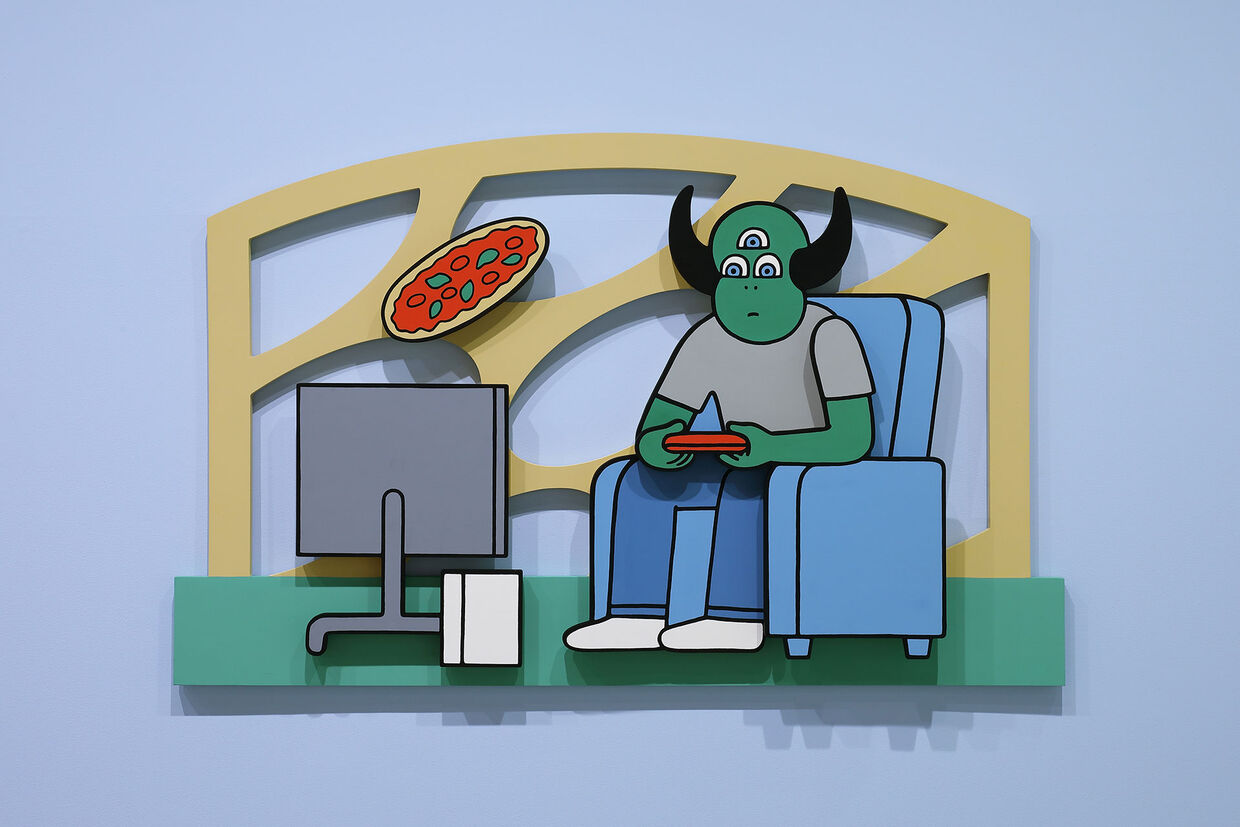--How did you come up with the concept of D_I_S_T_A_N_C_E? Please tell us about the highlights of the exhibition.
It usually takes me a long time to come up with a concept. Though I was asked to participate in 2019, I hadn’t been able to make up my mind. As 2020 came around and I needed to make a decision about the idea of the exhibition, the coronavirus pandemic began to wreak havoc. By spring, those in Japan were forced to shift lifestyles. That’s when I decided on the theme of “new feelings of distance.” I had a hard time deciding whether or not to use such a direct title such as “DISTANCE”, but since my works are relatively direct and easy to understand, I’m glad I went with it. So, under the theme of (new) feelings of distance, I depicted people whose lives were altered by the coronavirus pandemic. I don’t think there are many shows (at least in Japan) that have dealt with this theme in such a straightforward way, so I would be pleased if the audience can sense this.

--When did you start to draw? What made you decide to become an illustrator and artist?
I always enjoyed drawing, but it was mostly doodling in the beginning. I would draw Dragon Ball characters in the corner of my notebook or on the back of a school test. I didn’t like sketching in art class. I didn’t find drawing landscapes interesting. So, I never truly studied art. At university, I learned the skills necessary to become a commercial designer, and after graduating, I became a graphic designer in my hometown of Nagoya. However, the office I worked for only produced menus and flyers for pubs and supermarkets. I didn’t find this interesting at all. It was very far from the kind of graphic designer I wanted to be. So, I thought, “what can I do to express myself?” That’s when I thought of being an illustrator. I had a vague idea of what an illustrator was, but to me, it was a job that only a select few could do. I couldn’t imagine it as a path I could take. But, since it didn’t cost much to live in my hometown, I decided to go for it.
--You have worked in a variety of genres. Is there a specific job that you consider to be a turning point for you?
When I was about 27 or 28 years old, I started working for a children’s TV show on NHK E-TV called Shakin! Before then, I had unstable income, but since getting regular orders every other week through this job, my life suddenly had some stability. I finally thought I could make a living off of being an illustrator.
--Please tell us about the process of creating your work. Do you create rough drafts by hand? How do you combine analog and digital processes? Do you use a tablet?
A few years ago, I tried to build a system that would allow me to do my drafts digitally, but in the end, I failed and I still start with a pencil. At first, I draw several thin lines and fine-tune those lines. I still find this process to be the hardest. After I scan that, I use a tablet. The only time I draw by hand is when I create works for exhibitions. Nowadays, the market for digital works has broadened, but for now, I still find my own analog works to be more valuable.
--Is there any conscious distinction you make between "design as work" and "design as self-expression"?
In my case, most of my work is commercial, so I basically draw as a job. I've been doing this for more than 10 years, so I've gotten used to it. Work as self-expression requires me to decide on my own theme, which still takes a lot of time for me. However, I received great responses from the exhibition at DIESEL ART GALLERY, so I feel like I’m getting the hang of it.

--Please tell us about your main piece, RED DOG, which is also a figurine. Is this character a representation of yourself?
Perhaps it is a representation of myself deep down, but I didn’t intend it to be. I feel like it is a symbol of a person who lives in a world that is becoming overly convenient, due to the proliferation of the internet.
--In addition to human characters, there is a skeleton character named "Scully" and a horned character named "Berobero". Which of your characters do you like the most?
I think Scully is my favorite because of its shape. I think that the gap between the image of death and the smiling eyes is cute. However, when it comes to work, it's hard to use it because of what a skeleton implies, so I use it in my own works like this.

--Of all the works you have done so far, which is your favorite? Which do you feel most connected to?
I like all the works in this D_I_S_T_A_N_C_E exhibition. It's rare for me to feel this way. I especially like the three canvas works because they show a new direction for me.
--When do ideas come to you? What is the source of your inspiration?
I never get ideas until I think very hard: Come! Come to me! When that doesn’t work, I buy old auction catalogues from Sotheby’s and Christie’s online and flip through them. It’s fun to look at these because unlike art books by specific artists, they contain works of artists of many periods.
--Are there any artists, movies, books, or music that have influenced you?
In the past, I was influenced by James Jarvis and Katsura Wakano. Now, I think I am less influenced by specific artists and more influenced by various things or events. As for movies, I like Tarantino and Kubrick because they are easy to understand, but I like a lot of things. It's difficult to specify because I like so many things. I don't listen to music that much.
--What artists/persons do you admire?
Shirane Yutampo.
--How do you spend your days off?
I spend most of my time off with my family. We go camping or go to the park. My wife likes to be very active, so I don't really relax at home.
--What things or events have inspired you recently?
I've been inspired by the recent trend of Japanese artists. Sometimes it’s overwhelming.
--What would you like to do in the future? What projects do you have planned?
I would like to work overseas more.
--Do you have a message for people who will be viewing your works including your fans, and aspiring creators?
I always think that I am able to exist because my fans care about me. Thank you very much. I really appreciate it.
If you want to become a popular artist, please imitate those who are popular. It will sell. If you want to be unique, create your own path. We live in an age where anything is possible, so you should keep trying anything that comes to mind.






















